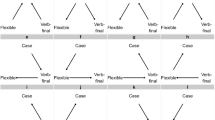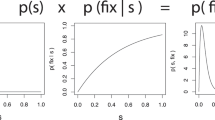Abstract
Both language and genes evolve by transmission over generations with opportunity for differential replication of forms1. The understanding that gene frequencies change at random by genetic drift, even in the absence of natural selection, was a seminal advance in evolutionary biology2. Stochastic drift must also occur in language as a result of randomness in how linguistic forms are copied between speakers3,4. Here we quantify the strength of selection relative to stochastic drift in language evolution. We use time series derived from large corpora of annotated texts dating from the 12th to 21st centuries to analyse three well-known grammatical changes in English: the regularization of past-tense verbs5,6,7,8,9, the introduction of the periphrastic ‘do’10, and variation in verbal negation11. We reject stochastic drift in favour of selection in some cases but not in others. In particular, we infer selection towards the irregular forms of some past-tense verbs, which is likely driven by changing frequencies of rhyming patterns over time. We show that stochastic drift is stronger for rare words, which may explain why rare forms are more prone to replacement than common ones6,9,12. This work provides a method for testing selective theories of language change against a null model and reveals an underappreciated role for stochasticity in language evolution.
This is a preview of subscription content, access via your institution
Access options
Access Nature and 54 other Nature Portfolio journals
Get Nature+, our best-value online-access subscription
$29.99 / 30 days
cancel any time
Subscribe to this journal
Receive 51 print issues and online access
$199.00 per year
only $3.90 per issue
Buy this article
- Purchase on Springer Link
- Instant access to full article PDF
Prices may be subject to local taxes which are calculated during checkout




Similar content being viewed by others
References
Cavalli-Sforza, L. & Feldman, M. Cultural Transmission and Evolution: A Quantitative Approach (Princeton Univ. Press, 1980)
Crow, J. F. & Kimura, M. An Introduction to Population Genetics Theory (Harper & Row, 1970)
Bentley, R. A., Hahn, M. W. & Shennan, S. J. Random drift and culture change. Proc. R. Soc. Lond. B 271, 1443–1450 (2004)
Reali, F. & Griffiths, T. L. Words as alleles: connecting language evolution with Bayesian learners to models of genetic drift. Proc. R. Soc. Lond. B 277, 429–436 (2010)
Pinker, S. Rules of language. Science 253, 530–535 (1991)
Lieberman, E., Michel, J.-B., Jackson, J., Tang, T. & Nowak, M. A. Quantifying the evolutionary dynamics of language. Nature 449, 713–716 (2007)
Michel, J.-B. et al. Quantitative analysis of culture using millions of digitized books. Science 331, 176–182 (2011)
Reali, F. & Griffiths, T. L. The evolution of frequency distributions: relating regularization to inductive biases through iterated learning. Cognition 111, 317–328 (2009)
Hooper, J. B. in Current Progress in Historical Linguistics: Proc. 2nd International Conference on Historical Linguistics (ed. Christie, W. M. ) 96–105 (North-Holland, 1976)
Ellegård, A. The Auxiliary Do: The Establishment and Regulation of its Use in English (Almquist & Wiksell, 1953)
Jespersen, O. Negation in English and Other Languages (AF Høst, 1917)
Pagel, M., Atkinson, Q. D. & Meade, A. Frequency of word-use predicts rates of lexical evolution throughout Indo-European history. Nature 449, 717–720 (2007)
Schleicher, A. Darwinism Tested by the Science of Language (John Camden Hotten, 1869)
Darwin, C. The Descent of Man, and Selection in Relation to Sex (Murray, 1888)
Haeckel, E. Natürliche Schöpfungs-Geschichte (Georg Reimer, 1868)
Bybee, J. L. & Moder, C. L. Morphological classes as natural categories. Language 59, 251–270 (1983)
Davies, M. Expanding horizons in historical linguistics with the 400-million word Corpus of Historical American English. Corpora 7, 121–157 (2012)
Labov, W. Principles of Linguistic Change Vol. 3 (Blackwell, 2010)
Kroch, A. S. Reflexes of grammar in patterns of language change. Lang. Var. Change 1, 199–244 (1989)
Christiansen, M. H ., Chater, N . & Culicover, P. W. Creating Language: Integrating Evolution, Acquisition, and Processing (MIT Press, 2016)
Croft, W. Explaining Language Change: An Evolutionary Approach (Pearson Education, 2000)
Prasada, S. & Pinker, S. Generalisation of regular and irregular morphological patterns. Lang. Cogn. Process. 8, 1–56 (1993)
Dahl, O. Inflationary Effects in Language and Elsewhere (John Benjamins, 2001)
Hawkins, J. A. A parsing theory of word order universals. Linguist. Inq. 21, 223–261 (1990)
Blythe, R. A. & Croft, W. S-curves and the mechanisms of propagation in language change. Language 88, 269–304 (2012)
Wright, S. Evolution in Mendelian populations. Genetics 16, 97–159 (1931)
Kandler, A. & Shennan, S. A non-equilibrium neutral model for analysing cultural change. J. Theor. Biol. 330, 18–25 (2013)
Hahn, M. W. & Bentley, R. A. Drift as a mechanism for cultural change: an example from baby names. Proc. R. Soc. Lond. B 270, S120–S123 (2003)
Blythe, R. A. Neutral evolution: a null model for language dynamics. Adv. Complex Syst. 15, 1150015 (2012)
Baxter, G. J., Blythe, R. A., Croft, W. & McKane, A. J. Modeling language change: an evalution of Trudgill’s theory of the emergence of New Zealand English. Lang. Var. Change 21, 257–296 (2009)
Cuskley, C. F. et al. Internal and external dynamics in language: evidence from verb regularity in a historical corpus of English. PLoS One 9, e102882 (2014)
Feder, A. F., Kryazhimskiy, S. & Plotkin, J. B. Identifying signatures of selection in genetic time series. Genetics 196, 509–522 (2014)
Jakobson, R ., Waugh, L. R . & Monville-Burston, M. On Language (Harvard Univ. Press, 1995)
Zipf, G. K. Human Behavior and the Principle of Least Effort: An Introduction to Human Ecology (Addison–Wesley, 1949)
Ullman, M. T. Acceptability ratings of regular and irregular past-tense forms: evidence for a dual-system model of language from word frequency and phonological neighbourhood effects. Lang. Cogn. Process. 14, 47–67 (1999)
Crawford, V. P. & Sobel, J. Strategic information transmission. Econometrica 50, 1431–1451 (1982)
Ringe, D., Warnow, T. & Taylor, A. Indo-European and computational cladistics. Trans. Philol. Soc. 100, 59–129 (2002)
Gray, R. D. & Atkinson, Q. D. Language-tree divergence times support the Anatolian theory of Indo-European origin. Nature 426, 435–439 (2003)
Pagel, M. in The Princeton Guide to Evolution (ed. Losos, J.) Ch. VIII.9 (Princeton Univ. Press, 2013)
Pagel, M. Human language as a culturally transmitted replicator. Nat. Rev. Genet. 10, 405–415 (2009)
Lupyan, G. & Dale, R. in Language Structure and Environment: Social, Cultural, and Natural Factors (eds De Busser, R. & LaPolla, R. J. ) Ch. 11 (2015)
Tamariz, M ., Ellison, T. M ., Barr, D. J . & Fay, N. Cultural selection drives the evolution of human communication systems. Proc. R. Soc. Lond. B 281, 20140488 (2014)
Acknowledgements
We thank H. Bacovcin, T. Kroch, and M. Liberman. R.C. acknowledges support from the University of Pennsylvania Research Foundation. J.B.P. acknowledges support from the David & Lucile Packard Foundation, the US Defense Advanced Research Projects Agency (D12AP00025), and the US Army Research Office (W911NF-12-1-0552).
Author information
Authors and Affiliations
Contributions
M.G.N., C.A.A., R.C., and J.B.P. conceived the study, designed the analysis, and wrote the paper.
Corresponding author
Ethics declarations
Competing interests
The authors declare no competing financial interests.
Additional information
Reviewer Information Nature thanks R. A. Bentley and the other anonymous reviewers for their contribution to the peer review of this work.
Publisher's note: Springer Nature remains neutral with regard to jurisdictional claims in published maps and institutional affiliations.
Extended data figures and tables
Extended Data Figure 1 Time series of changing rhyming patterns.
Each panel shows the time series of a polymorphic verb (black lines), repeated from Fig. 2a, and the frequency of similar-sounding monomorphic regular (orange) and irregular (blue) verbs in the Corpus of Historical American English. The tokens included are all tenses of those lemmas that possess a pronunciation known to the Carnegie Mellon University Pronouncing Dictionary in both the lemma and the simple past tense. The list of verbs incorporated in each time series is given in Extended Data Table 2. For 17 polymorphic verbs we find no similar-sounding monomorphic irregular verbs (all-orange panels). The title of each panel indicates the sign of the maximum-likelihood selection coefficient, either regular → irregular or irregular → regular.
Supplementary information
Supplementary Information
This file contains supplementary text S1.1 – S1.7 and Figure S1 - Temporal trends in the usage of 36 verbs, in the simple past tense and in all tenses. (PDF 371 kb)
Rights and permissions
About this article
Cite this article
Newberry, M., Ahern, C., Clark, R. et al. Detecting evolutionary forces in language change. Nature 551, 223–226 (2017). https://doi.org/10.1038/nature24455
Received:
Accepted:
Published:
Issue Date:
DOI: https://doi.org/10.1038/nature24455
This article is cited by
-
The use of scientific methods and models in the philosophy of science
Scientometrics (2024)
-
Measuring frequency-dependent selection in culture
Nature Human Behaviour (2022)
-
Evolutionary stability of ambiguity in context signaling games
Synthese (2021)
-
Neutral syndrome
Nature Human Behaviour (2020)
-
Cross-Linguistic Data Formats, advancing data sharing and re-use in comparative linguistics
Scientific Data (2018)
Comments
By submitting a comment you agree to abide by our Terms and Community Guidelines. If you find something abusive or that does not comply with our terms or guidelines please flag it as inappropriate.



